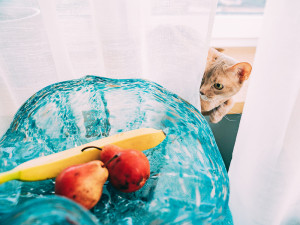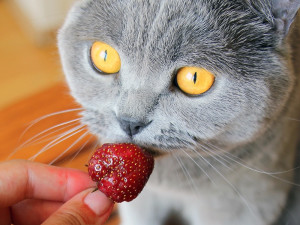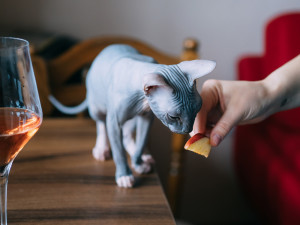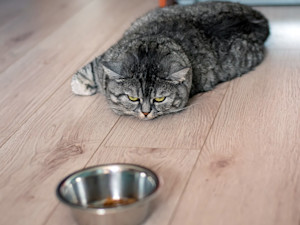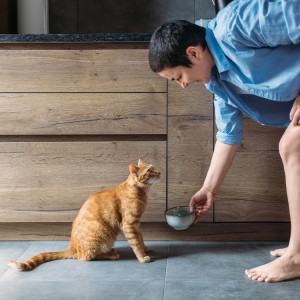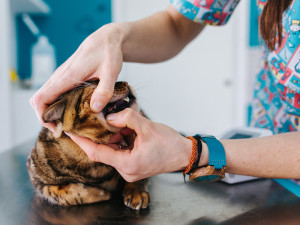Can Cats Eat Grapes?
This is one you’ll want to bookmark
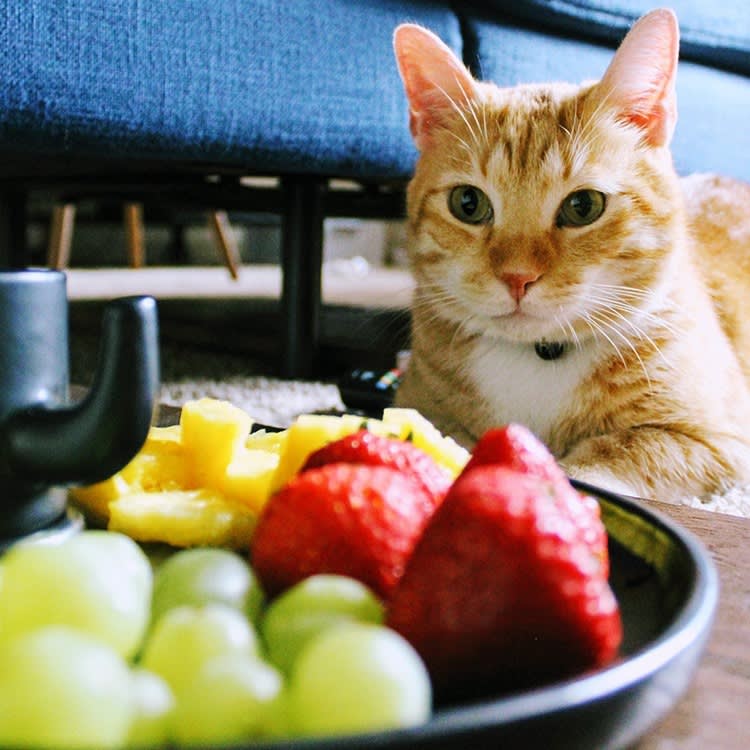
share article
Grapes and their cute little shrivelled up cousins, raisins, make delicious sweet treats for us humans, but this is one food that you definitely should not share with your cat. Cats should not eat grapes or raisins because they contain toxins that can cause serious illness, including kidney failure. There is still a lot that veterinarians are learning about grape and raisin toxicities and the actual toxins within them.
More documented cases of toxicities have occurred in dogs than cats, so much of the information we have comes from studies in dogsopens in a new tab. This may be because dogs are just more likely to devour a bunch of grapes compared to cats – who have very refined, selective palates. It may also be the case that the toxins have a more serious effect in some species versus others. For now, the best way to play it safe is to keep grapes and raisins safely out of reach of your cats and any other pets in your house.
Nutrition facts for grapes and alternatives for cats
There’s nothing cuter than watching your cat tilt their head with curiosity as they are exploring new foods, batting them around and maybe even taking a bite, so you may be wondering what kinds of human foods are safe for your kittyopens in a new tab to investigate. While there are many human foods that you can safely feed to your cat in moderation, grapes are not in that category.
Grapes contain many beneficial nutrients for humans, including antioxidants, fibre and important vitamins and minerals, but they are unfortunately toxic to cats. All efforts should be made to keep them out of reach. This is also the case for raisins, currants and sultanas, all of which are part of the plant genus known as Vitis.
The good news is that your cat’s food should contain all of the necessary nutrients for their daily diet, as long as it is labelled as being complete and balanced. If you are looking for ways to provide an extra boost of vitamins and nutrients to your cat’s diet, there are other food options that you can offer them that are safe and delicious.
Antioxidants: antioxidants can protect cells against damage from free radicals and have benefits throughout the body. Blueberries are also packed with antioxidants and can be safe for cats in small amounts.
Fibre: fibre helps to feed the good bacteria in the gut and prevent constipation. Many other fruits and vegetables contain fibre, including pumpkin, and this can be a safe, occasional treat for your cat. For cats that have ongoing health problems related to constipation, a special diet may be more beneficial so be sure to consult your veterinarian.
Vitamins and minerals: fruitsopens in a new tab and vegetables also tend to be great sources for many important vitamins and minerals. If you want to give your cat an extra serving, there are many options that are safe opens in a new tabfor the occasional taste or treat.
Are grapes good for cats?
Grapes are not good for cats because they contain toxins that can make them very sick. For a long time, veterinarians have known that grapes and raisins are toxic to pets, but it was only recently that we have come closer to identifying their toxic propertiesopens in a new tab. Studies of damaged kidneys after grape toxicity suggest that it is very similar to the damage from toxins in the baking ingredient Cream of Tartar and the tamarind fruit.
All of these foods contain potassium bitartrate, which is a salt of tartaric acid. Other plants also contain this toxin if they are members of the genus Vitis, including currants and sultanas. When ingested, these toxins can cause multiple toxic effects. Some common signs of toxicity include:
belly pain
loss of appetiteopens in a new tab
signs of kidney failure: urinating large amounts, drinking a lot of water or not urinating at all in later stages
If you see your cat eating grapes or you find shredded evidence that maybe they had some when you weren’t watching, contact your vet immediately. Depending on the quantity and the timeframe of when you think they were eaten, your vet may recommend treatments including inducing vomiting, monitoring your cat’s kidney values with blood tests and/or hospitalisation with IV fluids and other medications to protect the kidneys and digestive tract.
Can cats eat grape leaves?
Toxicologists believe that the toxic compound is only found in the fruit of the grape itself, so the leaves are not thought to contain this toxin. It would most likely be OK for a cat to nibble on a leaf, but consuming a large amount of these leaves could lead to digestive upset including vomiting and diarrhoea and would not be recommended anyway.
Can cats eat products with grape flavouring?
Many processed products, such as jam or grape juice, are usually detartrated, meaning they may contain little to no potassium bitartrate. This makes them much less likely to have toxic effects. This is also often true of products that have been heated, such as baked goods containing grapes or raisins. The amount of potassium bitartrate in different products can vary, however, and should be avoided to be safe.
The bottom line: can cats eat human food?
When it comes to sharing your food with your cat, it’s always important to double-check that what you are offering is safe for your feline friend. There are many foods that are safeopens in a new tab in moderation, but there are also some foods we eat all the time that are surprisingly toxic to cats.
If in doubt, consult your vet before offering your cat something new. Always make sure that what you offer is free of spices and oils that could be problematic for your cat, even if the main ingredient is safe.
Be sure to avoid foods that may be a choking hazard or cause injuries to your cat’s digestive tract, such as foods with bones, shells, toothpicks or skewers. And finally, remember that cats have very unique nutritional requirements so they must get the bulk of their diet from a balanced cat food diet. The occasional scrap of human food may be a delicious treat, as long as it is less than 10 percent of your cat’s total diet. Most important of all, be sure to provide your kitty with appropriate, nutritionally balanced cat food.
Other foods that are good for cats
If you are looking for healthy snack options to share with your cat, consider some of these:
Watermelon can be a refreshing treatopens in a new tab to share with your kitty.
Peanut butter is high in protein and good fats.
Apples are a great source of fibreopens in a new tab and many important vitamins.
Other foods that are dangerous to cats
Garlic is toxic to cats and can cause life-threatening anaemia.
Onions are toxic to cats and can cause fatal health complications.
Chocolate is toxic to cats and can cause a range of health problems depending on how much is ingested.
Frequently asked questions
How many grapes can a cat eat?
Cats cannot eat any grapes. This food can be toxic to cats, so the safest approach is to avoid it completely.
Is it OK to give cats grapes?
It is not OK to give cats grapes because they are toxic. There is still more that veterinarians are learning about how the toxins in grapes affect cats and the safest bet is to avoid them completely.
Why do cats like grapes?
Cats may be curious about grapes especially because they roll around and may be fun to chase. However, because they are toxic to cats, they should be kept out of reach and cats should not be permitted to play with them.
Can cats eat grape skins?
The whole fruit of the grape is considered toxic to cats; this includes the skin, fruit and seeds of the grape.
What should you do if your cat eats grapes or raisins?
Contact a pet poison hotlineopens in a new tab or bring your cat to the closest available vets right away.
References:

Dr. Amy Fox, DVM
Amy Fox, DVM is a small animal veterinarian in New York City. A lifelong animal lover, Dr. Fox studied biology in college and then worked as a veterinary nurse before pursuing veterinary school at Cornell University. She has worked in many different settings including shelter medicine, emergency medicine, general practice, and animal cruelty and forensics. She is especially interested in nutrition, preventative medicine and care for senior pets. Dr. Fox also enjoys writing about veterinary medicine and teaching. In her free time she loves to cook, garden, and go for long runs.
Related articles
![]() opens in a new tab
opens in a new tabHow to Get Your Pernickety Cat to Try a New Food
Discover the ways to get your picky eater to expand their culinary horizons
![Person with short hair putting water bowl on floor for cat]() opens in a new tab
opens in a new tab8 Ways to Get a Cat to Drink Water
Their desert-dwelling roots might resist hydration, but these tricks can help
![Young female veterinarian in her consulting room performing a medical examination on a pet]() opens in a new tab
opens in a new tabWhat You Need to Know About Cat Mouth Ulcers
How to spot, diagnose and treat the painful lesions – whether cancerous or non-cancerous
![Grey and white longhair cat sitting in a cardboard box with a Christmas tree and blurry festive decor in the background]() opens in a new tab
opens in a new tabHoliday Safety Tips for Festive Felines
Chances are, your cat is already plotting some Christmas chaos. Fear not, veterinarian Dr Aimee Simpson has tips on how to safeguard your holiday spirit and your pet
